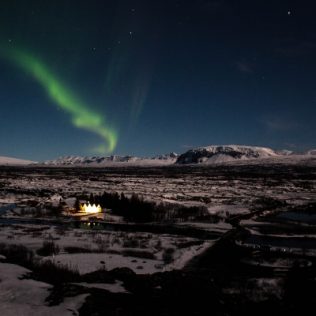Iceland is home to only 300,000 people scattered across a handful of towns and villages. Therefore, the country has many areas without any manmade light sources that offer a unique chance to view the night sky without any light pollution. When it comes to seeing the Northern Lights, these conditions are perfect.
Iceland is one of the best places in the world to see the Northern Lights, also known as the Aurora Borealis. You can witness the Northern Lights in Iceland almost every night in the autumn and winter months and in much warmer weather conditions compared to other viewing locations in Scandinavia.
To maximize your chances of spotting this beautiful natural phenomenon, you need to research the best time to see the Northern Lights in Iceland and plan ahead before booking a trip. To help you with this, we’ve put together a guide on how to see the Northern Lights in Iceland.
Why Do the Northern Lights Happen?
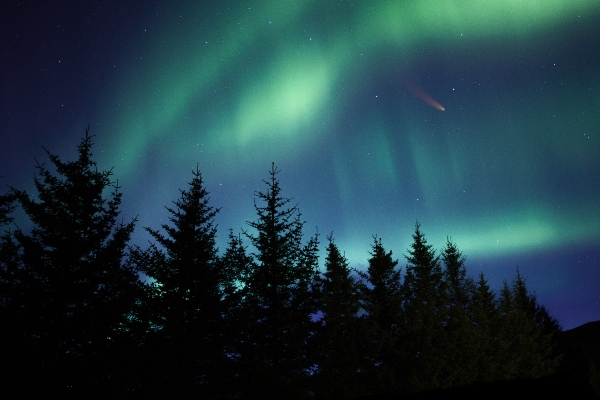
People have been sharing interesting stories about the Northern Lights for many centuries. Due to a lack of scientific understanding, generations from centuries ago came up with mythical stories about the appearance of these spectacular lights, which usually involved gods and monsters. However, as our understanding of the solar system has become clearer, these legends and myths have been replaced with scientific explanations.
The appearance of colorful lights in the sky is due to electrically charged particles from space entering the Earth’s upper atmosphere at a fast pace. The particles are formed due to the solar storms at the star’s surface. Most particles are deflected away, but some get captured in the Earth’s magnetic field, which accelerates down towards the north and south poles into the atmosphere.
What you see in the Iceland night sky are these atoms and molecules in the atmosphere that collide with the sun’s particles. The light’s wavy patterns and curtain-like features are formed due to the force lines at the Earth’s magnetic fields.
When Can You See the Northern Lights in Iceland?
Winter
Winter is the best time for seeing the Northern Lights in Iceland because it is so dark, and the country enjoys longer nights during this time of the year. Some regions will enjoy up to 19 hours of darkness around the winter solstice, offering plenty of opportunities for seeing the Aurora Borealis.
Although the Northern Lights appear the most in the winter, bear in mind that the weather at this time of year is also very snowy and stormy, which can make reaching the best places to see the Northern Lights quite difficult. Also, the sky can get very cloudy in the winter, which may make it difficult to see the lights in the sky.
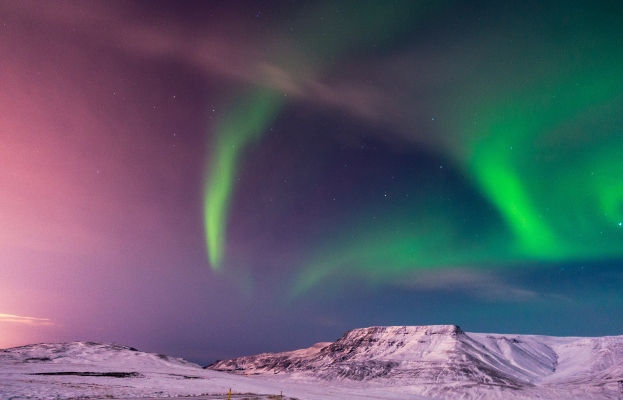
Spring
Spring in Iceland starts in the middle of March until mid-June. It’s one of the best times of the year to explore the country’s stunning natural landscapes, and while it may not be the best time to go to Iceland for the Northern Lights, it still allows quite a few opportunities to spot the lights at the start of the season.
In spring, there will be lots of Aurora Borealis activity around the solar equinox. There will be lower chances of lights than in winter, but there will be higher chances of clear skies. Thus, you will have plenty of opportunities to witness the incredible display of lights.
If you plan to go to Iceland in spring for the Northern Lights, schedule your visit at the start of spring. Avoid visiting towards summer if you’re really hoping to see the lights, as your likelihood of seeing the Northern Lights decreases at this time of the year.
Summer
Although the Aurora Borealis is active all year round, you won’t be able to see the lights in summer. There is too much daylight during this time of the year, and there are not enough hours of absolute darkness for the lights to be visible.
In the Arctic Circle, the sun barely dips below the horizon during summer, bringing in continuous daylight. Since it’s just too bright in summer, the chances of spotting the Northern Lights are incredibly low.
Autumn
In Iceland, the autumn season begins in late August and continues until late October or early November. It’s the best time of year to see the Northern Lights, as the autumn equinox produces more geomagnetic storms, leading to some of the most spectacular displays of lights.
As the winter season approaches, your likelihood of seeing the Northern Lights increases towards November. The skies are clearer during this time of the year, offering a perfect condition for seeing the stunning lights, and the usually favorable weather also means fewer clouds will obstruct your views.
As a bonus, the autumn season in Iceland has milder temperatures than the winter, so you won’t end up with numb fingers and toes as you wait outside for the lights to appear. Therefore, you can stay outdoors for longer as you enjoy the astonishing lights display.
The Best Place to see the Northern Lights in Iceland
Þingvellir National Park
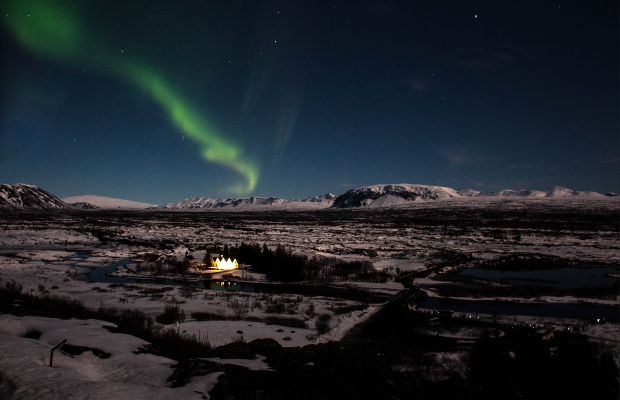
The Þingvellir National Park is a popular destination for witnessing the Northern Lights in Iceland. Set in a Rift Valley in Southwest Iceland, the park is a designated World Heritage Site due to its cultural and historical significance.
It’s not too far a drive from the capital of Reykjavik; about 35 miles northeast along Route 1. If you’re visiting in winter, make sure to check the weather reports, as the roads are plowed on most days during this time of the year but can sometimes be obstructed after heavy snow.
Þingvellir National Park offers some of the clearest night skies necessary to see the Northern Lights in all of Iceland, which is why it’s such a popular place to go and spot them. Aside from witnessing the lights, the park contains various hiking trails and offers plenty of opportunities for outdoor activities such as angling and horse riding.
Jökulsárlón Glacier Lagoon
Jökulsárlón is a beautiful glacial lagoon that should be on your Iceland itinerary, whether you’re coming here for the Northern Lights or not. It features an utterly magnificent landscape that shines even more beautifully at night; an ideal location for seeing the lights in Iceland.
Located in the southeast part of the country, bordering the Vatnajokull National Park. To get to the lagoon, you can drive along the Ring Road from the town of Vík.
Jökulsárlón’s crystal-clear ice boulders pick up the Northern Lights’ red and green glow, which creates a stunning kaleidoscopic effect. As such, the Lagoon is a beautiful spot for photographers who want to capture magnificent views of the Northern Lights.
Consider booking a tour to the Jökulsárlón Glacier Lagoon to make the most of your visit, maximize your chances of seeing the lights, and also get the chance to experience things like ice hiking.
Reynisfjara Beach
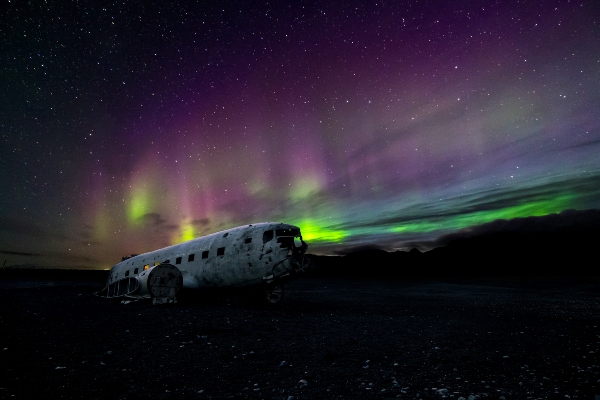
Reynisfjara is a black sand beach located in the southern town of Vík. It’s known for its black sands and unique basalt columns.
According to legend, the basalt stacks at Reynisfjara Beach were trolls guiding a ship towards the shore. When daylight comes, it is said that they transform into sharp needles of rocks, forever stranded in the sea.
Reynisfjara Beach is one of the best places for viewing the Northern Lights in Iceland because of the unique features of the location that make it a particularly dramatic place to view the lights. It’s easy to reach the beach when you travel by car, and parking is free of charge so you can stay and wait to try and spot the lights for as long as you want.
Kirkjufell
Kirkjufell is a gorgeous mountain beautifully framed by a waterfall and surrounded by lush greenery. Located on the north coast of the Snæfellsnes peninsula, the mountain is just over two hours’ drive from the capital city of Reykjavík which makes it a particularly popular location to see the Northern Lights.
The scenery around Kirkjufell already looks magnificent even without the Northern Lights. But when you combine the striking slopes with the dramatic beauty of the Aurora Borealis, you’re treated to an incredible snapshot of natural phenomena that you won’t find anywhere else in the world.
Grótta Nature Reserve
Grótta is a nature reserve located at the tip of the Seltjarnarnes Peninsula in the north-westernmost part of the Greater Reykjavík Area. Although many visitors come here to witness the stunning display of the Northern Lights, the area offers plenty of other interesting things to discover.
Home to an abundant species of birds, Grótta was made into a nature reserve in 1974. Featuring a rugged coastline and surrounded by black sands, it’s a wonderful place to admire the views of the Aurora Borealis. The park also has an old lighthouse that looks very picturesque, especially with the Northern Lights in the background.
If you’ve rented a car on your trip to Iceland, then getting to Grótta is pretty easy, as it’s only about a 10-min drive from downtown Reykjavik. But if you don’t have a car, you can get there in a taxi or bus.
Ásbyrgi Canyon
Located about 24 miles east of the town of Húsavík, Ásbyrgi is a spectacular canyon located within Vatnajökull National Park. The horseshoe-shaped canyon is several miles long, formed by cliffs divided through the center by interesting rock formations with a scenic lake at the end. It’s truly a beautiful place to view the Northern Lights in Iceland.
Ásbyrgi lies about 60 km from the town of Húsavík, Iceland’s whale watching capital. If you’re driving, you can get here through road 85. The place is well-signposted, so you just need to turn to road 861, which will lead you to the Visitor’s Centre, campground, and hiking trails. Road 85 is accessible all year, even during winter when the road conditions are somewhat challenging.
Summary
Seeing the Northern Lights in Iceland requires knowledge, patience, and research. The lights will not appear on any kind of schedule, and you may have to wait for a few hours in your chosen spot before they appear.
To guarantee the best views, schedule your visit in winter, early spring, or late autumn. But remember that even if luck is not on your side when it comes to witnessing the Northern Lights, there are still many exciting things waiting for you to do in Iceland during the winter season.
Hiring a car is one of the best ways to explore Iceland and visit some of the sites where you’re most likely to catch a glimpse of the Northern Lights. If you’re planning a trip to Iceland and want to find out more about outstanding vehicle rental options, get in touch and speak to one of the team at Fara Car Rental for more information.
